I’ve been using my Kinesis Advantage keyboard for two months, and I love it. I’ll never go back to a regular keyboard again if I can help it.
There are a few downsides to it, however. The biggest one is that split distance between the two sides is fixed. It doesn’t have Cherry MX blues (although the browns plus the firmware beeps is pretty nice). It doesn’t have layers, really — just a ten-key under the right hand. And honestly, it’s not very portable.

I took the Kinesis out to a coffee shop a few times before they all dried up into drive-thrus, and plunking it down on a four-top out in public made me realize just how large and loud it really is.
And so I’m building an ErgoDox keyboard. What I really want to build is a Dactyl — a curved variation on the ErgoDox — but I can’t just go whole-hog into that without building some type of keyboard first. That’s just my practical nature, I guess. I realize that the comparison is weak, because I’ll have to hand-wire the keyboard matrix when I make the dactyl. Assembling an ErgoDox is child’s play, comparatively. Our goal today is to lay out just what I’m getting myself into with a build like this one.
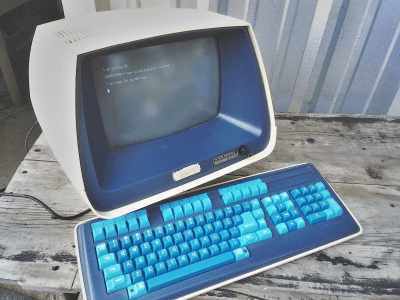
You can buy ErgoDox kits, but I like to go about things in my own weird way, and to better get my head around this, I wanted to figure out what all the pieces are instead of having the information handed to me. You can also buy these keyboards already put together, but what’s the fun in that? This way, I can save next to no money at all, and do all the labor myself!
I’m trying to take everything into consideration as I do this, which of course includes making it look as cool as possible. I went with a clear acrylic case because transparent electronics are truly the best type of electronics.
The first major aesthetic decision was sealed when I ordered PCBs with blue solder mask. So keeping in mind that the boards will show through the case, I’m going with a dual or maybe triple blue colorway on the keycaps — something like the keyboard on the Data General Dasher terminal.
Parts and Labor
So what are all the parts? The most fun ones to think about are the case options, the key caps, the switches, and the cables — one mini-USB to connect to the computer, and one TRRS audio cable so the two halves can talk to each other. But all that stuff is just icing on the cake. Before we bust out the pastry bags, let’s crack a couple of eggs here.
PCBs
The ErgoDox can have between 76 and 80 keys, and the difference is in the thumb clusters. You can either have eight regular-sized keys, or four regular and two doubles like the Kinesis.
There’s one left and one right PCB, but the design is interchangeable, meaning you need two of the same PCB. You can buy sets of them already made, or grab the gerbers and have ’em fabbed. I went with the second option. I really wanted purple PCBs, but the board is big and complicated enough that it just wasn’t going to be cost effective, so I tried a new board house.
I could have ordered PCBs from the same place where I got the case parts and all the electronic components, minus the switches. But I thought it would be nice to have backup boards in case I screw something up royally. For some reason, I thought I would be getting five sets, because it showed two boards when I uploaded the zip file. Nope. Got five boards, as in 2.5 keyboards’ worth. But I’m pretty sure that a single board can be used by itself if you solder the Teensy to one side and the I/O expander on the other. If so, look out for a post about a massive mono-manual Maltron-esque macro matrix. Mmm.
Controller and Components
The ErgoDox is designed to be controlled with a Teensy 2.0 running open-source firmware like QMK. I’m not sure if a higher-caliber Teensy will work or not. I bought a set of components that included the Teensy — it felt like it was cheaper than sourcing everything individually. Each of the 76 key switches gets a 1N4148 diode, and the ErgoDox PCBs are designed to allow for either through-hole or SMT diodes.
Since the Teensy has nowhere near 76 I/O pins, the keyboard uses an I/O expansion chip to set up a matrix of rows and columns. Rounding out the components are a handful of passives, a TRRS jack for each half, a mini-USB jack, and three LEDs that let you know which keyboard layer you’re operating in.
Case and Cables
Besides being fun, the case actually makes a difference in keyboard design and construction. This keyboard is designed to have plate-mounted key switches, which means there is a layer with 76 key switch-shaped holes in it between the switches and the PCBs. This adds stability to the switches and reduces stress on the solder connections. You can find the files to cut or print your own case layers, and plenty of people out there will sell you pre-made case pieces.
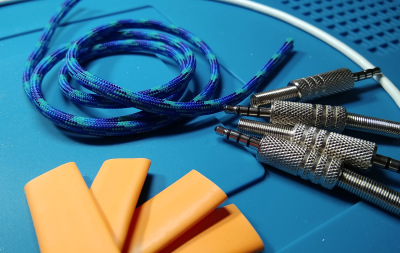 I love me some see-through electronics, so my case is five layers of transparent acrylic — top, bottom, key switch plate in the middle, and two spacer plates between those. The only thing I regret is not going in and changing the ErgoDox logo to literally anything but Comic Sans, cause it’s gonna show through.
I love me some see-through electronics, so my case is five layers of transparent acrylic — top, bottom, key switch plate in the middle, and two spacer plates between those. The only thing I regret is not going in and changing the ErgoDox logo to literally anything but Comic Sans, cause it’s gonna show through.
Like I said, you need a TRRS cable and a mini-USB. If you buy the components piecemeal, you’ll need a second sacrificial mini-USB to extend the Teensy connection out to the edge of the board. I bought a set of components that included a DIY mini-USB connector that only needs wires and assembly.
It’s sort of traditional to have a sexy TRRS cable with a paracord sleeve and a matching USB cable to go with it. Pre-made cables aren’t cheap, but making your own is quite affordable. I’m holding off on ordering the USB until I see how this paracord looks with the blue of the PCBs and the sample color chips I ordered from a keycap manufacturer.
The Sound of Silence Switches!
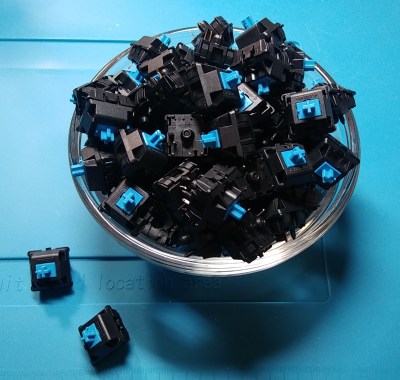
Cover your ears — the switches are going to be Cherry MX Blues. Blues are loud, but it’s okay, because I’ve been working from home since before it was mandatory. I thought about getting Browns because that’s what the Kinesis has and I’ve grown to like them, but blues are so delightfully crisp and clacky.
Browns are tactile instead of clicky, and they take about five or so fewer grams of actuation force, which is good for anti RSI purposes. But since I won’t be using this keyboard for super long periods of time, I think blues will probably be okay.
For a minute, I thought about putting browns in all the pinky and ring finger slots, and blues everywhere else, but I’m kind of afraid the keyboard will sound weird and throw off my typing momentum. But like I said, the idea to build the ErgoDox and subsequently the Dactyl is to have a portable split ergo keyboard to take out to coffee shops instead of the giant Kinesis, should I get the opportunity to do that again in this lifetime. Part of the reason the Kinesis is loud is because of her cavernous, echoing case. If the ErgoDox ends up being loud enough to bother people, I can always put little sound-dampening o-rings on the stems of the keycaps.
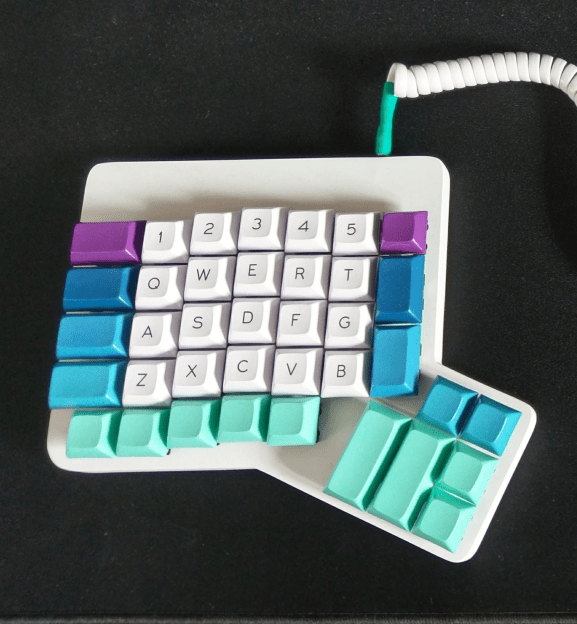
Keycaps
And now we have come to the best, most fun part of the build. It’s also the most nerve-wracking to decide upon, but that’s okay, because keycaps are easy to change. They’re like little outfits for your keeb, or hats if you prefer. Keyboard Layout Editor is a great tool for trying things on.
As fun as they are to look at, the ‘caps are also a functional part of the build. The material and the style can make or break a keyboard’s utility, depending on what you want to do with it.
Fantastic Plastic
Material-wise, there are two major options: ABS and polybutylene terephthalate (PBT). I don’t have to tell you what ABS is — Dan Maloney does it better, anyway. PBT is thicker, higher quality plastic with a nice feel. It’s able withstand UV light without discoloring, and will resist developing a slimy sheen from finger oils for a lot longer than ABS.
The sides of PBT keycaps are smooth, but the tops have a pleasant rough feel to them. The worst thing about PBT keycaps are that they come in far fewer colors than ABS. I don’t know exactly what keycaps the ErgoDox will have yet, but they will probably be blank PBT in shades of blue and maybe purple.
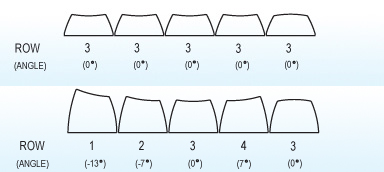
Stylin’ and Profilin’
The other difficult thing about choosing keycaps is deciding on a keycap profile — this refers to the way the keys are shaped and the tops are sculpted (or not sculpted). If you look at most standard, non-chiclet keyboards from the short side, you’ll see that the tops of the keys are shaped differently from row to row.
To reduce finger travel distance, the profile of upper rows like the F keys and number keys usually tilt downward, the ZXCVB row tilts upward, and the spacebar row is convex. The home row, which is row 3, is the flattest, though not all families have a flat row 3.
I love the look of SA profile caps, but they are super tall and might fatigue my stubby fingers. I’m leaning towards DSA because I bought some with homing bumps for the Kinesis, and I like how shallow they are. As long as I get all row 3s, they’ll be uniformly profiled and should be an easy transition back to a flat keyboard. DSAs key caps are also a good option for the Kinesis, so if they don’t work out on the ErgoDox, then they have a place to go.
This can be a real money pit of a hobby, a hobby with a capital H if you will. I knew that going into this, and I went in just the same. Here’s hoping I only build keyboards I will use, and recycle the rest.
















Nice. I was just looking at doing the same thing yesterday. I haven’t used either a split keyboard or one without offset keys before, so it will take a bit to re-learn typing skills. I also don’t know how well I’ll like the different kinds of switches out there over the long haul. Decisions, decisions. I’m in the design / ordering phase now. Keep us posted!
As long as your touch typing is pretty good you’ll be able to adapt to split and ortholinear without too much trouble. The main downfall will be any little bad habits like using the wrong fingers for B, C, , 6
I found out through switching to a split that somehow I’d learned to press “t” with my right index finger and “y” with my left index finger.
Do not buy Mx blues, trust me. There are a million better switches.
If you want clicky, check out kailhs offer like the jade or pink.
Too late, my home row homie. I have some jades and blues on hand. Yes, they are awesome, but they take more force than I’m willing to give all day. Same with Cherry greens. I do think that maybe I should have used clears instead, but ¯\_(ツ)_/¯
I typed on an IBM M for more than a decade, Gateron browns for years, and have been on real honest-to-goodness Cherry blues for the last year (with vintage Blacks desoldered from used keyboards on the modifier/thumb keys!). I think I’m gonna go Red next, probably in a Dactyl-inspired design.
You just gotta explore. And all the testers in the world can’t compare with actually putting some weeks/months into a full keeb and see if you like it. And that’s half the fun anyway.
IMO, any nice switch is soooo much better than the normal/bad keyboards, that virtually anything you do will be usable if not “perfect”. You can’t really go wrong, even if you later find that in retrospect you could have gone righter.
I choose blues for my first build, loved it at first but after about 2 months I couldnt stand the sound anymore :D
Anyway, welcome to the club of mechanical keyboards…Its a darn rabbit hole. Im on my 5th or 6th board already and keep drifting towards vintage boards more and more…
I’ve got clears on my WASD and love them. I might try browns on a 10-key before I build out a 104/5 with them.
I’ve spent quite a lot of time with my ErgoDox and found it excellent. Greatly enjoyed the process of building it as well.
I made a tool to automatically generate a layout visual aid from the configured source files downloaded from the formerly massdrop ergodox firmware/layout configurator. Details here: https://geekhack.org/index.php?topic=22780.msg1035938#msg1035938 and here: https://geekhack.org/index.php?PHPSESSID=5p3esam4b6j5adu3uk8ethvil8l7hv9b&topic=22780.msg1024010#msg1024010
This helped me to learn the 4-layer datahand-dvorak-inspired layout I made for myself.
Maybe you’ll find it convenient to track down that massdrop firmware configurator, or maybe just the .svg.m4 template will prove useful. YMMV.
Enjoy building your ErgoDox. I highly recommend a hot air gun with surface mount diodes for the matrix, because it is just magical watching surface tension pull all of those diodes into the right orientation.
Thank you for documenting your build. I’ve become interested in building my own, by reading articles on Hackaday (S*CK was another.)
What are going to do with blank keycaps? Do you have a process to label them? I looked into this and found CO2 laser is the wrong tool (its the only hammer I have access to though!). Instead, infrared laser is used on PBT.
I want/need totally custom function keys etched. Love those sky blue PBT keycaps.
One thing I’ve been unable to find is a longer space bar. Most of them are 6 or 6.5. I want 7 or 8. The C-64 on http://www.keyboard-layout-editor.com/ shows one, but I haven’t found anywhere that sells that space bar.
Another really fun thing I did: Use OpenSCAD to create keycap models, then my imagined keyboards.
Also maybe of interest to builders. I’m a handicapped, one-hand typer, for 40 years. The most I can manage is 5+1 fingers. The ergo keyboards do not speak to me – in fact they make me wince.
I share your concern about unbounded cost. I started with the $50 S*CK plan so far, but, I have stocked up a lot of Cherry switches to try out.
Pmk will sell 7U space bars in a variety of profiles and colours.
https://pimpmykeyboard.com/sa-spacebars-pack-of-1/
If you can touch type there is no real need for labels on your key caps – imho.
I never managed to learn touchtyping, so I’m just a fast hunt ‘n pecker, but I’ve found that if I stop looking at the keyboard I can still type pretty well.
If you’ve been using keyboards for years, try not looking! You’ll be surprised at how well your fingers remember where everything is.
Have a look into dye sublimation. https://www.youtube.com/watch?v=-scV7LLvdh8 I have never done it so I dont know how durable it is in the long run. Just a relevant video I saw a couple days ago.
Can someone please explain what the big deal is with mechanical keyboards? I personally prefer quiet keyboards with medium to low stroke length. I think I would go absolutely nuts if I had to constantly hear loud clicks and feel mechanical clicks – too much feedback for me! I’m not criticizing, I just keep seeing this interest in mechanical keyboards and am genuinely curious if there’s more to it than I’m aware of.
I like a quiet keyboard as well. I also don’t work with music playing and hate the TV been on.
I figure there is enough noise inside my head I don’t need any more.
Its about the look, sound and feel, but most importantly the options of different formfactors and layouts. Makes work a lot more fun, healthy and productive. A hairdresse buys good scissors, a capenter a decent table saw someone sitting on a desk all day a proper keyboard.
I’ve got a nice mechanical keyboard, and to be honest, I don’t really notice much difference over a half decent membrane one. As long as there’s at least a medium stroke length I’m happy.
The main advantage for me is that mechanical keyboards tend to be much better built, more ‘premium’. My Das Keyboard has a solid metal chassis, media buttons, and a couple of USB3 ports on the back and that’s the features that make me love it.
The sound doesn’t bother me much, but my keyboard has brown switches, which are supposed to be medium quiet I think (they can still make a nice clack noise though).
Of course, everyone is different, so I’d advise borrowing one if you can, and see how you get on with one.
The difference is that the switch point of a membrane keyboard is literally you pressing a carbon pad onto an inflexible circuit board. Switch activation is at the end of travel, so you’re repeatedly banging your fingers into the PCB.
With mech switches, they switch somewhere around 1/2 way through their travel, which means that you never have to bottom out / hit your fingers on anything. This is probably faster, but certainly also better for RSI.
The whole tactile feedback / sound / weight thing is all just about how you know when you’ve activated the key. Without bottoming out, that is.
My personal take is that the tactile bump that you feel is much more important than the sound (so browns > blues), but also that I type just fine on keys without any appreciable feedback (blacks and reds) just by keeping an intentionally light touch, which can quickly become habit. If the switch point is 1/2 way through the travel, you have a lot of room for slop. IMO/IME/etc.
All of this. And if you are looking for a quieter keyboard, try out the Cherry MX Red Silents. I have an ErgoDox EZ with these keys, and it is honestly much quieter than my old membrane keyboard ever was. A large part of that is the difference in activation point that Elliot mentions above. With a bit of practice you stop right after activation, not when the key bottoms out. Better for both acoustics and ergonomics.
Yeah right? I’m putting reds in my next keyboard. (After good experience with blacks, which are like heavier reds.) But it feels really strange from a former buckling-spring devotee to be typing quietly.
I totally agree. But hey feel so nice, and my wife (who shares an office atm) doesn’t have to collect my life insurance just yet.
Also, NB the Red Silents are different from just Reds. And not everywhere carries them. But IMO they are worth the difference.
Build a dactyl instead. Coming from the advantage the lack of a well and the spacing of the thumbcluster is super fucked up on the ergodox
If I ever wanted an ergonomic keyboard, I’d go with a chorded one. Probably Braille, as I am already partially blind, with keys for shift, number/symbol modes and some common combinations. Actually that’s a great idea. And such a keyboard can be split into separate parts to work as mobile/wearable interface for smartphone or other VR/AR system…
If you want a nice sculpted set of keycaps for your Ergodox, an alternative to SA is the MT3 profile. It’s not quite as tall, and has a great retro vibe. It’s not the blue theme like you’re hoping for, but in the last day or so the /dev/tty keycaps became available again on Drop ( https://drop.com/buy/drop-matt3o-devtty-custom-keycap-set#overview ) and they have Ergodox kits available. (Fingers crossed that Drop will run Dasher/Dancer in MT3 at some point).
(I use MT3 godspeed on my crkbd keyboard and really like it as a profile).
Nice, I have a ErgoDox as well but a slightly different version that uses USB C instead of TRRS. Each half can be a master. It took some time to get used to but the columnar key layout is so much better, I will never go back. The keyboard is quite portable, I took it to work every day. My ergodox originally came with clears linear switches that would activate if you rested your fingers on them. I replaced them with red linear switches and I quite like them over the browns tactile switches on my original Poseidon keyboard.
I actually want to try making the dactyl as well – and maybe something with a analog stick for gaming. If you make the dactyl then I would love to see a build on it!
If you’re thinking of DSA keycaps, look into XDA and MDA.
I’d love to see you get qmk on your kinesis. It’s really nice. Here is the pcb for the advantage 2. It uses a teensy 2.0++ and some ffc connectors. https://github.com/joeyjyliu/kinesis_adv2_qmk
Check out this reddit: https://www.reddit.com/r/ErgoMechKeyboards/
I’m totally clueless about PCB fabrication. Can you enlighten us more with how you created them? In https://www.aliexpress.com/item/32690550796.html I see multiple options and I have no idea what should I choose (copper thickness, board thickness, etc…)
I used jlcpcb.com for PCB fabrication.
The logo is not Comic Sans.